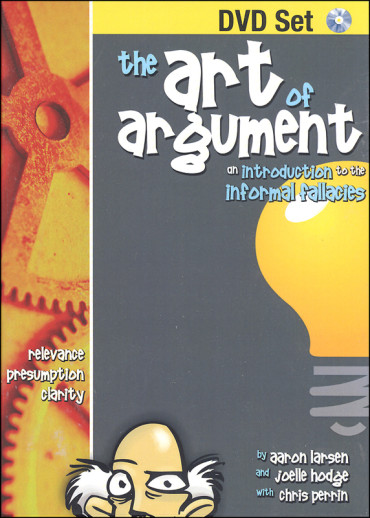We use cookies to make your experience better. To comply with the new e-Privacy directive, we need to ask for your consent to set the cookies. Learn more.
Art of Argument DVD Set
Middle and high school students will argue (and sometimes quarrel), but they won't argue well without good training. Students who complete The Art of Argument will know how to reason with clarity, relevance, and purpose . . . and have fun along the way! They will study and master 28 logical fallacies, which will provide an essential lifetime framework for filtering good and bad reasoning as well as writing and speaking effectively. This mastery of informal logic is a foundational subject by which other subjects are evaluated, assessed, and learned.
Students will enjoy using The Art of Argument 5-DVD Set as 3 experienced logic teachers and 4 capable, enthusiastic students discuss the 28 fallacies presented in The Art of Argument Student Edition. This video series is a valuable resource for every student and teacher using The Art of Argument. Each video segment (approximately 15 minutes per lesson) features one fallacy, which is presented, defined, and then discussed and explored using a blend of enthusiasm, contemplation, and humor. Each discussion seeks to make a practical application of the fallacy to student life, advertisements, political speech, or various kinds of ethical and philosophical debates.
Buying for a school? The Art of Argument video is a great tool for the classroom! It can be used as:
- a resource that will refresh and inspire the teacher
- a classroom resource for modeling and provoking discussion of the logical fallacies
- a substitute teacher when the regular teacher is away
- a resource for creating a summer school course
- a library item helpful to a struggling logic student or a curious parent
The Art of Argument video contains:
- More than 8 hours of content
- 28 videos—one for each fallacy contained in The Art of Argument text
- Fun outtakes, extras, and "logical" humor
Socrates is the "go to" person when it comes to fallacies (occurrence of bad or incorrect reasoning) and his perspective on the three basic categories - fallacies of irrelevance (points that don't relate to the issue), of presumption (assumptions that are not justified or necessary), and of clarity (language that confuses and muddies) - is sought via time-travel. Several examples of each are provided plus the student has the opportunity to identify fallacies in cleverly fabricated magazine advertisements. Fallacies are printed on the inside covers of the Student Text for easy reference. Both Student and TE (each about 230 pgs, pb) have appendices that include a play and a short story that illustrate fallacies as well as a Glossary and Bibliography. TE includes reproducible chapter, unit, and final exams (with answer key). DVDs include 28 sessions (one for each fallacy) in which three teachers and 4 students present, define, discuss and explain the fallacy. As in the text, the DVDs emphasize a practical application to the student's life through advertisements, political speeches, and various moral/ethical debates.


We have the art of argument books and are excited to add the dvd set to it.
I thought this would help us more with the book and information presented
Reviews online seemed great and wanted something for my teens to help them as they mature in this culture to defend their beliefs.
We want to teach logic but it looks like it will have to wait until the summer.